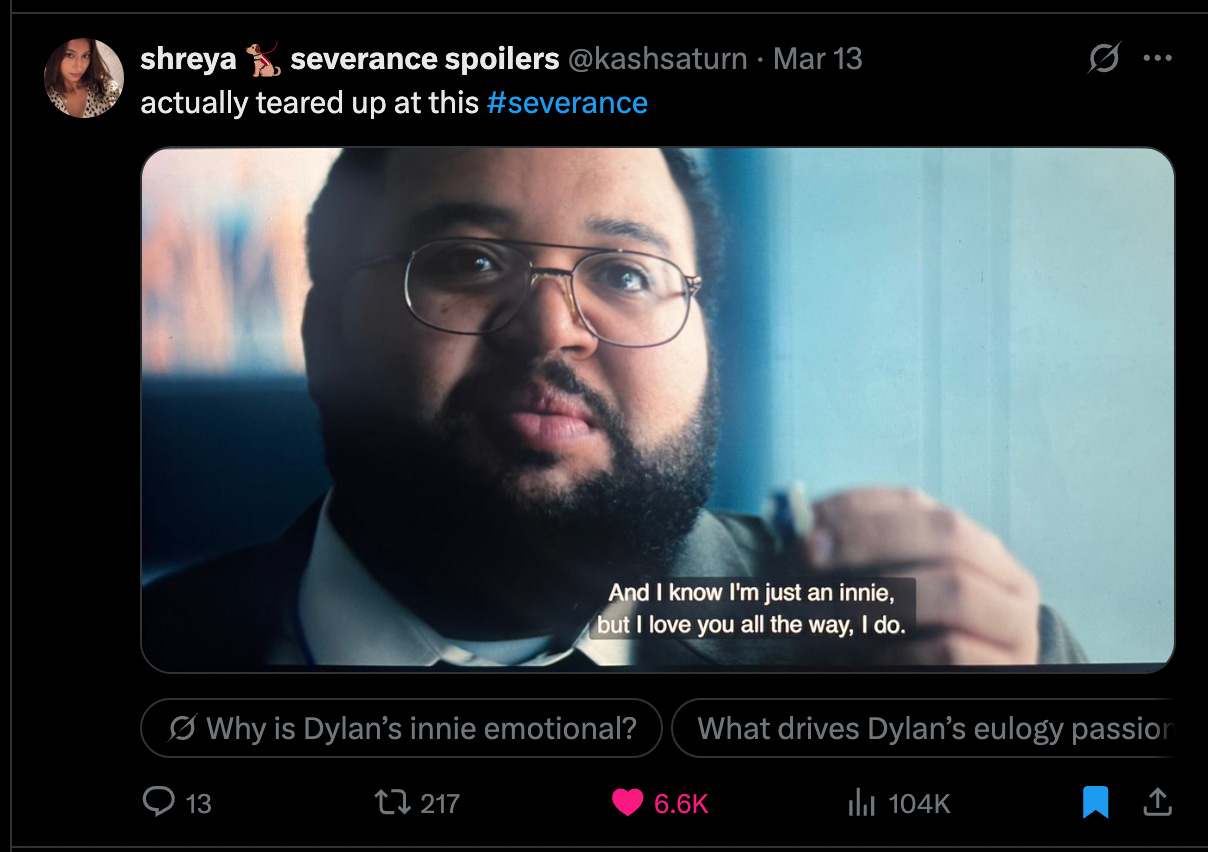Is Severance A Recession Indicator?
So, here’s the breakdown–we are all innies and outies.
Like what you read? Liking posts on Substack, sharing, and subscribing are all much appreciated ways to support the work of Words From My Wits’ End. Talk soon<3
*Spoilers for Severance, sorry!
Like many Twitter and TikTok dwellers, I have found myself engrossed in the twisted world of Apple TV+’s Severance. The show follows a shadowy biotechnology company called Lumon as they pioneer severance technology that allows some employees to maintain separate consciousness and memories in and out of the workplace, so as to not spill company secrets, with the added benefit of escaping the chaos and sometimes the tragedy of their lives on the outside.
For most of the show’s two season run, director Ben Stiller took viewers on a journey through a labyrinth designed to satirize corporate America. As one of the show’s main characters, Mark Scout (Adam Scott) says in one episode, “the work is mysterious and important.” The corporate board worships the company’s 19th century founder, Kier Eagan, as though he were a god like deity, with severed workers, referred to as “innies,” reduced to nicknames and the occasional ten-minute dance and melon party as a reward for good behavior. The innies also include Helly R. (who is moonlighting for Helena Eagan, the daughter of the company’s CEO, played by Britt Lower), hardworking husband and father Dylan S. (Zach Cherry), and painter Irving B. (John Turturro), a motley crew that has captured the hearts of viewers.
A number of the core group of severed workers the show follows, who work in the company’s cryptic Macro Data Refinement department, chose to take a break from reality due to grief, divorce, and the stress of parenthood. For 8 hours a day, they essentially have a clean slate of memories, free from the traumas that anchor them in life. And yet, as the severance lines blur, the tethering of both selves becomes more evident with each passing episode, especially now that viewers know that Lumon faked Mark Scout’s wife, Gemma Scout’s, (Dichen Lachman) death, and are holding her prisoner for their experiments.
Naturally, the themes of the extremes of a work-life balance, critiques of capitalism, and corporate America’s impact on small communities, have all led to a conversation surrounding what defines a cultural recession indicator. The last American recession lasted 18 months from 2008-2009, and Gen Z and millennials have become increasingly aware of the pieces of music and media that they associate with this period (whether you were jamming to Born This Way on an iPod nano or were old enough to wear business casual in the club).
Amid the Severance buzz, The Substance swept awards season, and Oscar-winning-director Bong Joon Ho’s film Mickey 17 similarly tells a story of multiple versions of the same character. What all of these programs have in common is that one version of self is weathered and experienced, and the other is a reminder of youthful innocence and simpler times.
In another Trump economy, the nation is yet again on the brink of recession, amid looming international tariffs and a number of other policies that are looking to shock the economy. So, is Severance a recession indicator?
During the 2008 recession, a lot of the subject matter present in music involved partying, or general upbeat production. Think early Lady Gaga, Kesha, and the sweeping romance of Taylor Swift’s sophomore album Fearless. In television, this meant the success of a number of comedy shows, including Parks and Rec, The Office, 30 Rock, and more. This all offered a breath of fresh air to contrast the grim realities of the recession that particularly plagued countless middle and working class families across America–from foreclosures to layoffs and tight budgeting.
Now, 17 years later, in an era in which the everyday person now has a level of hyper accessibility and visibility to the rest of the world, an upbeat song on the radio is just not enough anymore. The secret is out–many are struggling in intricately nuanced ways under this economy and political climate, and people not only yearn for simpler times, but simpler versions of themselves. Such can be said of the brutalist structure of the Lumon offices that appear in Severance, and the childlike wonder of the innie workers at simple joys like waffles and fruit platters, and Mark and Helly R.’s ability to fall in love unbound by the chains of their trauma. All the while, everyone is dressed practically in functional business casual, which was all the rage for millennials in their early 20s in the 2008 recession, largely because of the skyrocketing cost of living and plummeting salaries.
The New York Times recently reported that the office space used for Lumon’s headquarters is not a soundstage, but Bell Works, a real complex in Holmdel, New Jersey. Growing up in a New York City commuter’s town in central New Jersey during the recession has allowed me to have a unique view on Severance. In many ways, the working parents of my hometown walked the line of being severed and tethered, entering a new reality, in a far off land on the other side of the Hudson River, through the heavy shroud of factory smoke and away from the quiet chaos of suburbia, yet never quite out of reach.
Only viewers can evaluate if Severance is a recession indicator, but yearning for a simpler version of oneself and an easier world certainly makes it feel that way. Our outies have become skilled at escapism and coping by way of internet humor, but would we really like to be severed? Time will only tell.






